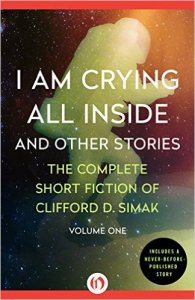Paul Di Filippo reviews Clifford D. Simak
I Am Crying All Inside and Other Stories: The Complete Short Fiction of Clifford D. Simak, Vol. 1, by Clifford D. Simak (Open Road 978-1-5040-1267-6, $15.99, 332pp, trade paperback) October 2015
 When Robert Heinlein died on May 8, 1988, the SF field of course mourned his passing en masse. But in that shared and dominant sadness, as frequently happens in life, the mourning process for another writer who had died just a couple of weeks earlier, on April 25, 1988, got short-circuited and somewhat swamped. I refer to the passing of Clifford Simak.
When Robert Heinlein died on May 8, 1988, the SF field of course mourned his passing en masse. But in that shared and dominant sadness, as frequently happens in life, the mourning process for another writer who had died just a couple of weeks earlier, on April 25, 1988, got short-circuited and somewhat swamped. I refer to the passing of Clifford Simak.
Simak started his career earlier than Heinlein—he sold his first story in 1931—and he arguably finished at a higher peak of sustained personal competence than Heinlein did. Simak’s last book was Highway of Eternity; Heinlein’s was To Sail Beyond the Sunset (both being curiously poignant and fateful titles). Honored with a Grand Master Award in 1977, Simak was the third recipient of that trophy, after Heinlein and Jack Williamson—a true indication of his stature at the time.
Much as I loved Heinlein’s work, I loved Simak’s more, in what was perhaps a different fashion. If you can imagine both men as uncles, then Heinlein was the loudly dressed, blustering uncle who blew into town once a year from Manhattan, trailing clouds of glory from his exotic exploits and dazzling you with his cosmopolitan ways; whereas Simak was your local bachelor uncle who lived modestly in a cabin and who could always be counted on to fix your bike or take you fishing or console you when your dog died. And he never mentioned that he had a Purple Heart medal tucked away in his sock drawer.
But precisely by having this unassuming nature, in both his personality and on the page, Simak did not generate as many headlines or partisans as did Heinlein. And since his death, it seems to me that his star has unjustifiably faded a bit. There was a laudable attempt a decade ago to get all his stories into print. But the project fell apart after only two (now highly collectible) volumes: Physician to the Universe and Eternity Lost & Other Stories.
Now comes Open Road Media with the stated intention of issuing all of his short fiction in fourteen books. Hooray! Maybe the Simak Renaissance is finally here!
The first three volumes are out now, but only number one has a hardcopy so far, with numbers two and three being ebooks only. Perhaps if sales are good, subsequent volumes will get the option of the physical format that I for one still prefer.
We open with a short, informative intro by David Wixon, the man in charge of the project. And then we jump into Simak’s mid-career, with a story from 1959, “Installment Plan.” So, unlike, say, the Haffner Press Jack Williamson books or the Sturgeon series from North Atlantic, we will not be approaching the stories in strict chronological order, but rather getting a sample from across the whole career with each volume. That’s a very valid tactic too, I think.
“Installment Plan” is an almost perfect introduction to Simak’s worldview and themes and style. This tale of an expedition of human traders and their robot allies who come to the enigmatic planet of Garson IV gives us—atop its suspenseful mystery underpinnings—thoughts on: the nature of consciousness and emotions; competition and cooperation between species; the logic and necessity of economics and scams; the need for resilience; the interaction of the maker and his tools; and the place of humanity in the universe. All within a “conventional” SF adventure format. Simak’s distinctive voice, which blends intensely felt immediacy with ruminative asides and musings, is at its mature peak here. He and his protagonists are true philosopher-doers, Emersonian action bards of the spaceways.
The next story comes from the unseen pages of Ellison’s Last Dangerous Visions, and “I Had No Head and My Eyes Were Floating Away Up In the Air” proves to be almost Tiptree-esque in its in-your-face portrayal of the nastier side of mankind. A “venal man” attempting to enslave a whole planet finds himself locked into a new kind of bodily existence. He finally thinks he has his existential paradox solved, but his self-deceit undoes him.
“Small Deer” is a great time-travel story which starts out amusingly—two rural idiot savants invent a working time machine—then segues into almost a Hodgsonian horror tale.
The au courant biopunk of “Ogre”—from 1944, moreover!—reads like a combo of Rudy Rucker and Bruce Sterling. On a planet where plant life has evolved intelligence, the humans confront musical trees and symbiotic “life blankets” in a recomplicated romp. One aspect of Simak’s writing that is dominant here is his skill with wry comedy. While still dealing with important matters, he works in great comedic riffs. He helped to establish the template for less-consequential excursions of this sort from Keith Laumer and Christopher Anvil.
“Gleaners” prefigures the Company stories of Kage Baker. By highlighting the maddening bureaucracy of chrono-investigators Past, Inc., Simak de-romanticizes the already-by-then hoary time travel apparatus. And then he adds in a van Vogt kicker at the climax just to re-romanticize it!
The oldest story here, “Madness From Mars” is also the simplest—a strange beast from the Red Planet is not what it appears—but it still packs a narrative and emotional punch. We get a taste of Simak’s sophisticated pulp Westerns with “Gunsmoke Interlude.” The poignant blend of outlaw pride and familial duty requires a Gary Cooper or Jimmy Stewart to bring it to the screen. The naïve simpleton’s voice of the narrator in “I Am Crying All Inside” fits perfectly into a tradition of fantastika that asks the reader to inhabit a foreign mentality and truly grok it. On an Earth full of left-behind “losers,” old strictures of pride and shame still apply. Editor Wixon sees a Lovecraft homage in “The Call From Beyond,” and I’d have to concur. Out on quarantined Pluto, experiments have torn a rift in the dimensions, and evil things are sneaking through.
Finally, “All the Traps of Earth” is perhaps the most famous story in this gathering, and its selection highlights the fact that much of Simak’s fiction, including practically all of the rest of the Table of Contents here, remains undiscovered by modern eyes. The six-hundred-year-old robot named Richard Daniel must flee a mind-wipe. In doing so, he undertakes an odyssey across the stars that results in the kind of transcendence that critic Alexi Panshin identified as the core conceit of SF. Leave it to Simak to grant such an elevated status to a tin man, and make it achingly touching.
In “Gleaners,” our put-upon management man describes what time-travelers experience: “A haunting sense of unreality, the feeling that one was out of place, a hint of not quite belonging, of somehow standing, tip-toe, on the far edge of eternity.” Despite—or with the aid of—all his bucolic settings and Rockwellian protagonists, this is precisely the persistent itch and frisson that Simak felt and sought to convey. His enormous success is plain in the first volume of his oeuvre, and will manifest even more clearly with every subsequent book, until his unique rank in our field is finally recognized and secured.







So true, so true. Simak is one of the best SF writer’s from the “Golden Age” and he still speaks to the thoughtful reader today. I can’t wait to finally read all of his short fiction – now I won’t have to continue to track down so many that have never been published a second time.
As a fan of Simak’s since the 50s, I too wish the new collections were coming out in a form other than ebooks. Hopefully with your insightful comments, and good sales of the first volume, this project will see the physical light of day. Until then, I’ll be happy with the ebooks. Thanks for the review.
I have dedicated myself for over ten years to maintaining a website to the great SF short stories of Clifford Simak. I’m so glad that many of his stories are being made available. The coup here is “I Had No Head and My Eyes Were Floating Away Up In the Air” which I’ve waited 40 years to read. Nice to see a Western tale included. Simak has always been my favorite author ever since my high-school teacher made “City” mandatory reading.
Go Simak!
I am old enough to have read Simak the first time around. Always a good read.
And I think he would be amused, as I am, by a book called The Complete Short Fiction … which is the first of 14 volumes.